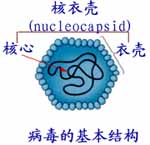1.衣壳,包膜与酶 Capsid ,Envelop, and Enzymes
(1)病毒粒子 virions

核心(core):(核酸,核髓)
|
第一章 病毒学基础 |
|
|
|
|
|
|
|
|
(三).病毒的结构(Viral Structure)
|
|
| 病毒的基本结构:
1.衣壳,包膜与酶 Capsid ,Envelop, and Enzymes (1)病毒粒子 virions |
||||
| 核衣壳(Nucleocapsid) |
|
衣壳(capsid) |
 |
|
|
核心(core):(核酸,核髓) |
||||
| 1.核 酸(Nuclei acid) | ||||
| (2)、包膜和包膜病毒、裸露病毒(Enveloped viruse and naked virus) | |
Envelopes usually consist of some combination of lipids, proteins, and carbohydrates 包膜(被 膜)病毒(Enveloped viruses): 很多动物病毒和少数细菌病毒的核衣壳外包着一层由脂质或脂蛋白组成的包膜,包膜上还可有刺突,这些具有较复杂结构的病毒称为包膜病毒。 Enveloped viruses: many animal viruses,some plant viruses,and certain bacterial virus; |
|
||
|
裸露病毒(naked viruses ,unenveloped viruses): 只有核衣壳这一基本结构而没有被膜的病毒。
|
||
|
右图是流感病毒的模式图。N刺突中的N表示Neuraminidase,即神经氨酸酶。H刺突中的H表示Hemagglutinin,即红血球凝聚素。 |
||
|
(3). 病毒的酶(enzymes) 病毒可以含有一种或者多种酶类参与其生命周期的构成,例如参与核酸合成的酶。这些酶类往往与被膜或者衣壳关联或者存在于衣壳内。
|
||
|
virion [5vaiEriCn]n.[微]病毒(成熟)粒子,毒粒,病毒体 nucleocapsid [nju:kliE5kApsid]n.[生]核壳体,核蛋白壳,核包核酸,病毒粒子 capsomere [5kApsEmE] n.(组成病毒壳体的)壳粒,衣壳粒 capsid [5kApsid]n.衣壳 neuraminidase[7njuE5minEdeis] n.神经氨(糖)酸苷酶, 唾液酸苷酶 hemagglutinin [5hi:mE5^lu:tinin, hemE-]n.红血球凝聚素 |
||
|
|
||
|
|
|||